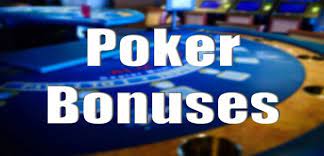In simple words the bonuses are the free money given to the players by the poker rooms. They are given in different ways, full house, heads up, and short stack. The first point to think about is that the amount of bonus differs from poker site to poker site. Full house offers are the most common type of bonus where the pots are guaranteed to be filled up. This means that if a player receives a full house in a game with blinds of $1 and $2, and has not played at $2 yet, the poker room will add $2 into the account. Then the $2 is put in a group of hands and eventually turned into a $4 tournament. The poker rooms do this for optimization, because it’s slow and complicated for a poker player to play in several games at the same time.
Heads up bonuses are usually awarded to players who win a specific hand in a certain round. This is done to encourage more players to stay in a game, and is usually done in tournament play. The highest awarded bonus is $1000, which is awarded to the winner of a heads-up battle. Unlike regular bonuses, if you bust out on your first game, you lose the bonus.
Short stack bonuses are offered to players who lose all their chips in a certain game. Because of the competitive nature of a sit and go, only a certain percentage of players ever win back their buy-in. Therefore, the poker rooms might keep a maximum of 50% of the players because that would be too expensive to have a super slow game. So what the rooms do instead is payouts the players proportionately. That means if a player has lost all his money and wins only 10% of his buy in, he still has $100 left because of the bonus.
There are a variety of bonus plans, but the most common is what the bonus is awarded on a percentage basis. The percentage can be straight up, fractional, decimal, American and International play, and more. It can be confusing, however if you try to look at it in different methods. For instance, if you take the linear bonus plan and split it into thirds, you have $1, $2, $3, $4, $6, $12, $24, $48, $ 96, $256, and $512. Basically, if a player received a $1 bonus, he would be getting 3/1 ($3) on the first $1. The second bonus would be $3/2 times the first bonus, or $7/1. The third bonus would be $4/3 times the first bonus, or $14/1, and so on.
Another type of bonus is a variation of the straight bonus plan. Where the player must earn a certain number of raked hands, then the bonus is rewarded as a percentage of the total amount of the player’s rake. For example, a player is awarded $1,000 after hitting $30,000 in accumulated rake. The player must then bet $1,000 / 30,000 in order to release the bonus in increments of $0. 50 cent ($0.50). This is unlike the straight conversion, where the bonus is instantly available; it has to be wagered before the bonus is credited to the player’s account.
Complex bonus plans can be fruitless, especially if the bonus flops and sees a lot of low volume players making the pot very small. It is rare, but if you are offered a bonus you should try to earn a little bit more than the asking price. The situation is even more acute in tournaments. During a tournament, the extra buy-in always attracts a lot of inexperienced players. Thebonuscl Mystiquetells you exactly where you stand in the game.Minimum deposit requirementmay be too high and no deposit bonus is much smaller. Before accepting a bonus, it is advised to play enough hands to release the bonus in full.
Opinion: European online 7meter. The reason why this site is good or bad depends on your point of view. If you come from a USA area, you will probably feel influx of excitement. You will try and search for promotions and you are likely to contact customer care… Customer care can be helpful even at the most odd hours.
